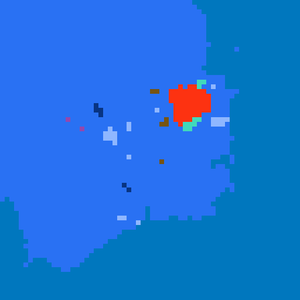water.extm
water.extm files describe the water heightmap and the texture of the main field and add-on content field.

water.extm File Specification
water.extm File Layout
Each file contains a 64×64 grid. For each vertex there is 8 bytes of data that describe the height of the mesh, the material type and flow speed.
Water Map Data
Each entry in the water data table is 8 bytes long.
| Offset (h) | Size | Data Type | Description |
|---|---|---|---|
| 0x00 | 2 | Unsigned Short | height (Vertex y component)
|
| 0x02 | 2 | Unsigned Short | xAxisFlowRate 128 = no flow
|
| 0x04 | 2 | Unsigned Short | zAxisFlowRate 128 = no flow
|
| 0x06 | 1 | Unsigned Byte | materialIndex + 3. This may act as a checksum?
|
| 0x07 | 1 | Unsigned Byte | materialIndex
|
height and flowRate are stored as unsigned shorts, but seem to map to float values. These can be calculated by dividing by the max size of an unsigned short:
32767 / 0xffff = 0.5
height is further multiplied by another constant to get the final height (the constant is unknown at this time, but is close to 0x300 / 0xffff).
x and z[1] can be calculated, while iterating through the data table:
for (int index = 0; index < 64 * 64; index++) {
uint x = index % 64;
uint z = index / 64;
}
Flow Rates are calculated as (flowRate * 2) - 1 and ranges from -1 to 1. On the x-axis this changes flow direction from East (-1) to West (+1) and on the z-axis from North (-1) to South (+1).
Material Index
This data is stored in Terrain.Tex1.bfres.
| id | file | name | attribute | attribute_sub | flag | Google Translated |
|---|---|---|---|---|---|---|
| 0 | Water | 水 | Water | Water | 0 | Water |
| 1 | HotWater | 熱湯 | Water | Water_Hot | 0 | Hot water |
| 2 | Poison | 毒水 | Water | Water_Poison | 0 | Poison water |
| 3 | Lava | 溶岩 | Lava | Lava | 0 | Lava |
| 4 | IceWater | 冷たい水 | Water | Water_Ice | 0 | Cold water |
| 5 | Mud | 泥沼 | Bog | Bog | 0 | Bog |
| 6 | Clear01 | 透明水01 | Water | Water | 0 | Clear water 01 |
| 7 | Sea | 海 | Water | Water | 0 | Ocean |
- ↑
zis expected to be an integer quotient. Thefloorfunction can be used if integer division is not supported.